Traditional patient-support programs must adapt to the new normal
Many elements of healthcare have changed since the onset of the pandemic, most of all patient behavior and the patient journey. The move to virtual health and telemedicine provides more opportunities to touch patients along all phases of their journey. Experts say these opportunities have always been there, but pre-COVID, patient services and patient support were seen more as nice-to-have items. During COVID, the value that additional 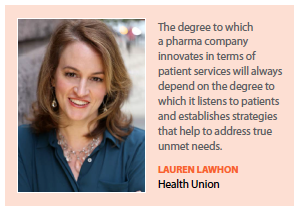 services brought to patients, and how well these services work as a product differentiator, became more apparent to pharma.
services brought to patients, and how well these services work as a product differentiator, became more apparent to pharma.
“So much has changed over the last 18 months, especially for patients and their journeys and, subsequently, patient services," says Tanya Shepley, associate principal, ZS. “COVID illuminated many of the gaps in our traditional patient-support models for the industry."
According to Ms. Shepley, COVID-19 has pushed the industry to identify new ways to reach patients and to build exceptional patient-support programs that marry their brand’s key attributes with the new reality of patients living with their condition.
“Across pharma, we’ve seen double-digit drops in engagement across the patient journey, including a decrease in doctor visits and fewer diagnoses, as a result of people staying home or sheltering in place during COVID," she says. “With historic unemployment, it makes sense that pharma’s initial response was focused on expanding financial assistance programs to help patients get or stay on therapy."
Finance Assistance is the Front Door to Patient Engagement
At the start of the pandemic, most patient services from pharma were therapeutic-driven and focused on limiting barriers to access. According to a report by ZS, early examples include campaigns from Eli Lilly and Company and Bristol Myers Squibb. Lilly offered $35 per-month insulin and utilized newspapers and social media to promote insulin affordability programs. BMS offered medicines at no cost to BMS patients who lost their jobs or health insurance due to COVID-19.
Tracey James, R.Ph., senior VP, pharmacy services, at AllianceRx Walgreens Prime, has several suggestions that pharma companies can employ to help patients experience uninterrupted access to medications now, and in a post-COVID world. “Companies should meet patients where they are," she says. “It is important to offer various ways to reach patients. As a specialty pharmacy, we offer options to make care more convenient. This ranges from answering questions about cost to helping them understand unique delivery instructions. Manufacturers need to develop thoughtful communication strategies for connecting when it is convenient for the patient. By collaborating with specialty pharmacies 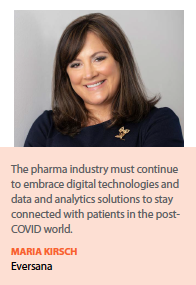 that have established relationships with patients, manufacturers can contribute to the customized digital experience."
that have established relationships with patients, manufacturers can contribute to the customized digital experience."
Ms. James adds that manufacturers should consider expanding eligibility for patient assistance programs, even in the short term, so patients don’t face having to choose between their medication or other vital resources. Further, manufacturers can work with specialty pharmacy partners to help align patients with appropriate resources to address the barriers, aka social determinants of health, and positively impact medication adherence.
“Finally, manufacturers can adjust access to patient-assistance programs," she says. “Pre-pandemic, patients typically learned about and enrolled in patient-assistance programs at the doctor’s office. Today, more people are using telehealth or skipping care altogether.
Manufacturers should consider ways to inform patients about their programs. Websites, patient portals, and other online tools can allow patients to access and electronically enroll in patient-assistance programs. These channels can increase awareness and reduce potential embarrassment a patient may feel telling their provider they need financial help."
Over the last few years — even pre-COVID — Christopher DiCostanzo, VP, patient engagement solutions at OptimizeRx, and his patient engagement team have worked with pharma manufacturers to launch many digital engagement programs that are attached to financial assistance. “One of the innovative ways that we have helped these teams drive awareness and participation in patient-support programs is by linking financial-assistance programs with treatment-support programs," Mr. DiCostanzo says. “Financial-assistance programs are often the primary reason patients interact with pharma after a prescription is written. We use that interest in financial savings as an opportunity to continue that first action and get patients the continued support they need, improving the patient journey."
OptimizeRx recently worked with a brand team seeking to deliver strong therapy initiation in a large patient population known for low-medication compliance. This therapy had a highly specific dosing requirement, and previous support programs had very low participation. Rather than waiting for patients to seek out support programs, OptimizeRx created a program that engaged patients at their highest point of motivation — aligning the medication copay offer with the therapy support program. Within the first year, more than 40,000 patients registered for the program and 72% of those patients were still adherent six months later. The program seamlessly enrolled patients in a text message-based program that reinforced medication compliance, encouraged timely refills, and provided educational information. It also provided tips and advice to help build adherence for patients.
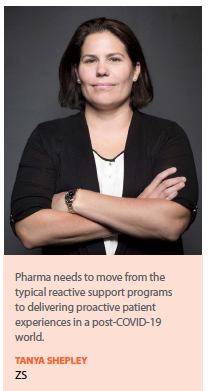 Delivering the types of patient services that align with patients’ needs at the most opportune time will be “refreshingly innovative" and most likely will become the new standard in patient support, says Jason Zemcik, VP, practice lead patient affordability at TrialCard.
Delivering the types of patient services that align with patients’ needs at the most opportune time will be “refreshingly innovative" and most likely will become the new standard in patient support, says Jason Zemcik, VP, practice lead patient affordability at TrialCard.
TrialCard is partnering with a major pharma client to design a reimagined patient-support experience rooted in a digital hub. The patient’s enrollment in copay assistance serves as the window into the full suite of additional patient support services, all managed via the patient’s account and available via web or mobile.
“Financial navigation — matching the patient with the right affordability support based on their coverage — is critical to enabling first starts and adherence to therapy by removing financial roadblocks," Mr. Zemcik says. “This can be accomplished through a combination of traditional patient-support services, such as benefit investigations and referral to charitable foundations, if the patient is ineligible for manufacturer-sponsored assistance, as well as by layering in eServices to program design to accomplish some of these tasks in a more streamlined manner."
Integration with third-party platforms within the broader healthcare ecosystem —specifically interoperable practice management platforms that match patients with available sources of financial assistance — is also extremely useful in delivering a more effective and efficient patient-support experience from a financial affordability standpoint, he adds.
In a post-COVID-19 world, pharma needs to move beyond a reactive support program to deliver proactive patient experiences, Ms. Shepley says. “Now is the time for pharma to offer more than just financial assistance, and define a new normal patient journey and strategic moments to address their patient’s current unmet needs," she says.
Mr. Zemcik agrees, saying pharma should recognize the importance of surrounding the patient with ancillary services that enhance the full treatment experience for both the patient and their caregiver(s). “Offerings such as nurse educator support for disease-state training, and teaching on medication administration, dosing, and side effects can lead to better adherence and more positive outcomes by helping patients be an informed participant in their plan of care," he says.
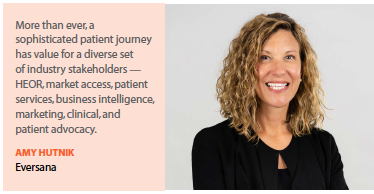 Additionally, a sizeable portion of the population is experiencing coverage changes due to COVID-related loss of commercial coverage and many states moving to expand Medicare programs. This can result in patients needing to explore alternate support options and, as such, providing guidance and education on available alternatives that may meet patients’ new needs can be critical.
Additionally, a sizeable portion of the population is experiencing coverage changes due to COVID-related loss of commercial coverage and many states moving to expand Medicare programs. This can result in patients needing to explore alternate support options and, as such, providing guidance and education on available alternatives that may meet patients’ new needs can be critical.
Although slow to start, the industry is increasingly responding with surprising agility, Ms. Shepley says, and has begun innovating new services to close some of the gaps for patients. “This is the new normal emerging," she says.
Preparing for the New Normal
Any tools or strategies that pharma companies employ post-COVID should keep in mind two major lessons around the patient experience that have been illuminated as a result of the pandemic, says Lauren Lawhon, president and chief operating officer, Health Union.
The first takeaway is that the human connection is vital, and isolation can have a significantly negative impact on health. The second point, which overlaps, is that the emotional elements of a patient’s journey need to be given equal weight to the functional and logistical aspects; to truly improve health, there must be a focus on removing both functional barriers and promoting emotional support.
“As a result, pharma companies should make sure their patient services are taking into account not just functional benefits, like affordability and access, but also more emotional and wellness-focused aspects, like how certain symptoms can impact one’s relationship or how stress impacts one’s ability to manage a condition," Ms. Lawhon says. “The most seemingly simple, but often overlooked, first step is talking to patients to gain better understanding of how pharma can develop patient services that best address their emotional, mental health, and other quality of life concerns."
Logistical and transportation burdens are common issues that patients face when trying to adhere to their treatment plans. When shelter-in-place orders made it difficult for patients to find an infusion center, Ocrevus, the multiple sclerosis infusion therapy, leveraged its existing navigator program to help patients find new infusion centers or even schedule home infusions during COVID, ZS reports. In another instance, BMS partnered with COA/CancerCare, an oncology advocacy group, to deliver free door-to-door patient transportation to make it easy for oncology patients to get to and from their appointments.
Some brands worked with telehealth providers to help patients get on therapy. Ubrelvy, Nurtec, and Linzess have all partnered with third-party telehealth systems to offer patients the option to schedule a telehealth service to get connected to a care provider.
“Nurtec launched during COVID, in the migraine therapy area, and the organization implemented a telehealth and digital approach right off the bat to launch," Ms. Shepley says. “They had a successful launch by having telehealth prominently up front."
In addition, the brand Linzess incorporated telehealth into its website before the pandemic and increased the prominence of that service during the pandemic. The organization has commented on the successful uptick in conversions to therapy through that channel.
Amy Hutnik, general manager, agency, advisory and evidence services, Eversana, gives an example of a more sustainable model from a client that was designed to improve patient care by re-engineering the patient journey to remote once COVID hit.
Eversana’s client received FDA approval for its product in March 2020, just as the COVID-19 pandemic began, Ms. Hutnik says. To ensure patients could get this vital treatment, they adopted a remote journey that included telehealth, remote diagnostics, including at-home echocardiograms, and ongoing monitoring. Patients were provided a dedicated nurse navigator who helped them throughout the journey, leveraging the power of technology and innovation. Patients were and are able to get all their questions on financial, treatment, and medication topics answered in real time.
According to Chase Feiger, M.D., co-founder and CEO at RxDefine, there is a lost opportunity for patients who have questions when first interacting with a pharmaceutical advertisement before determining they need to see a doctor. Most patient services primarily focus on the journey after a prescription has been written. The limitations of these HUB models are they only result in interactions after the doctor-patient relationship has been established and post-prescription, he says.
“Pharma manufacturers across specialty areas such as gastroenterology, psychiatry, neurology, obstetrics/gynecology, nephrology, cardiology, pulmonology, primary care, ophthalmology, and dermatology have recognized a heightened need for a pre-prescription model that can help consumers navigate all the disease information, choices, and decisions that need to be made before seeking care," Dr. Feiger says. “Through RxDefine, pharma brands and AORs can enable re-optimization of pharma marketing through a more consumerized and data-centric approach, as well as help humanize the interaction between pharma and consumer."
Another approach that adds to the personalization of patient services is through the use of patient advisory boards. At Health Union, market research has shown patient advisory boards and patient advisory councils can have a positive impact on both enabling patients to have a true voice in illustrating the nuances of their patient journey and helping pharma brands truly understand their needs. The most influential patient advisory boards bring in a variety of patient influencers and everyday patients to provide a detailed point of view on the impact of various aspects of the patient journey and illustrate the sometimes-misunderstood realities of people’s experiences. “Many companies are using innovative techniques to facilitate deeper understanding of everyday life from patient advisors, such as audio/visual diaries in digital ethnography, poetry, and virtual collages," Ms. Lawhon says.
Pharma brands may come into these patient advisory boards with a clear understanding of the steps patients go through along their health journeys, from experiencing symptoms to the diagnosis process to receiving treatments and so on. However, they typically walk out of them with a more dimensional understanding of how patients’ physical, emotional, mental, and social health are impacted along every step of that journey.
“The degree to which a pharma company innovates in terms of patient services always depends on the degree to which it listens to patients and establishes strategies that help to address true unmet needs," Ms. Lawhon says.
The Path Forward
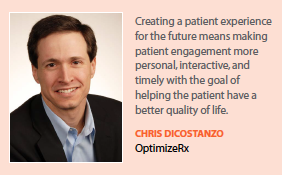 “The pharma industry must continue to embrace digital technologies and data and analytics solutions to stay connected with patients in the post-COVID world," says Maria Kirsch, senior VP and head of patient services operations at Eversana.
“The pharma industry must continue to embrace digital technologies and data and analytics solutions to stay connected with patients in the post-COVID world," says Maria Kirsch, senior VP and head of patient services operations at Eversana.
COVID demonstrated the ability to work and stay connected to communities of care and therapeutic support systems from anywhere. Patient services must adapt to this by creating experiences in which patients, caregivers, and HCPs can connect to patient-support programs in ways that fit much more naturally and organically into “e-consumer-like" behaviors, she says.
This is where technologies such as online chat, global support, secure portals, and structured reminders from text to emails to phone calls can serve patients best. “Patient services and support can’t be one more thing to do, or burdensome for practices, patients, and caregivers — they should be reducing burden via omnichannel approaches that put patients at the center," Ms. Kirsch says. “Successful patient-services programs will meet patients where they are."
“More than ever, a sophisticated patient journey has value for a diverse set of industry stakeholders — HEOR, market access, patient services, business intelligence, marketing, clinical, and patient advocacy," Ms. Hutnik adds.
But often the patient journey means something different to all of those stakeholders, leading to a breakdown in true understanding of a patient’s many milestones, experiences, emotions, questions and, ultimately, their improved health.
By using a robust methodology to map a patient journey, one can integrate clinical, emotional, and financial aspects of a patient experience into a single view. Qualitative methodologies capture the nuanced experiences of even the smallest patient groups, and analysis of primary real-world longitudinal data across hundreds of millions of patient lives informs quantitative views that inform truly innovative patient services.
“Armed with this differentiated view of the patients and their needs, we can move to omnichannel execution across an array of supportive experiences — where data help us anticipate everything from diagnosis to discontinuation, and interventions are planned and optimized in real time," Ms. Hutnik says.
Being able to understand each patient’s set of unique needs and help direct them to the appropriate next step in their journey is important for brands to understand as a way to capture an interested patient from the earliest point of awareness, Dr. Feiger says.
“Pharma has a unique opportunity to deeply engage with people through a variety of personalized educational initiatives as well as provide streamlined access to care, over and above the existing ‘talk to your doctor’ call to action," he says. “While there has been an explosion in the adoption of digital solutions, only 12% of patients are comfortable navigating today’s healthcare ecosystem."
Research at ZS has found that providing meaningful patient services in this new world requires consideration across four categories: activate, get, start, and stay. (See sidebar.) The first two categories represent empowering the patient, getting them in touch with a physician and then finding the financial assistance or reimbursement tools that are critical at this point in the patient journey.
“The last two areas are starting treatment and then staying and persisting on that treatment. These are the areas where the industry is using more creativity,"Ms. Shepley says. “The progressive companies are looking at different tools and resources to personalize and tailor outreach to patients. We see more social media being used, facilitated connection to other patients facing the same challenges being utilized, and ensuring there are alternative sites to care — this is all the new normal."
As patients become more aware of their role as consumers who can take more control of their journey, pharma should strive to create more interactive and timely support programs, especially post-COVID, when time with a physician may be more limited, Mr. DiCostanzo says.
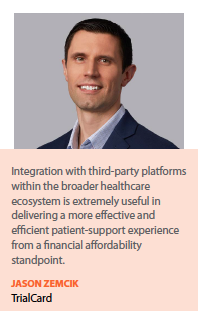 For example, a text-based patient-engagement program could help to ensure that patients are getting and reading therapy information that matches where they are during their therapy at that moment. “Text messages are read more frequently than emails, and the unique aspect of SMS is that information is more personalized and engaging than a website," Mr. DiCostanzo says. “While a patient is in a program, they are getting time-sensitive information, at the right time in the journey, based on when they started therapy. This is critical to continuing to engage the patient beyond the start of therapy."
For example, a text-based patient-engagement program could help to ensure that patients are getting and reading therapy information that matches where they are during their therapy at that moment. “Text messages are read more frequently than emails, and the unique aspect of SMS is that information is more personalized and engaging than a website," Mr. DiCostanzo says. “While a patient is in a program, they are getting time-sensitive information, at the right time in the journey, based on when they started therapy. This is critical to continuing to engage the patient beyond the start of therapy."
Solutions that acknowledge unmet needs and incorporate meaningful connection with others, especially fellow patients, offer the greatest opportunities for success in the new normal. On-demand video or audio assets are effective for meeting people where they are in their journey, along with real-time support occurring with online health communities that truly personalizes the experience.
“Digitizing patient services is an important step for addressing the needs of an increasingly digital society; the pharma industry should also be listening to patients and finding ways to humanize solutions," Ms. Lawhon says.
This is not always the case with pharma communications that tend to focus more on the 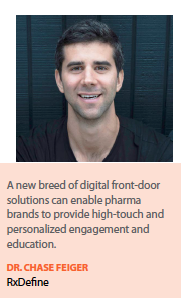 technical aspects of therapy, but neglect to address the patient as a human and a consumer, Mr. DiCostanzo says. Making treatment programs more human is crucial, especially during the initial weeks of therapy when the right patient support program can feel like a companion and establish reliability.
technical aspects of therapy, but neglect to address the patient as a human and a consumer, Mr. DiCostanzo says. Making treatment programs more human is crucial, especially during the initial weeks of therapy when the right patient support program can feel like a companion and establish reliability.
Taking a page from consumer products and delivering exceptional customer experience is the goal moving forward. If accessing support, either for the patient or physician, is burdensome, the program will fail. “Successful patient services platforms streamline and simplify processes and minimize administrative tasks, ultimately allowing the office staff and physician more time to connect and provide care for the patient," Ms. Kirsch says.
“That not only reduces HCP and office burden; it also reduces patient and caregiver burden to engender trust and appreciation for the brand and manufacturer, and — most importantly — it speeds access to therapy."
“Imagine the impact of a world where pharma marketing can turn basic brand awareness into a full-stack convenient and consumerized experience that allows for actionable next steps to equip people with the information they need and connect these informed people to their clinician of choice – all of which happens in near real-time, with the fluidity of e-commerce technology," Dr. Feiger says. “This is what pharma needs to create the patient-centric model of the future."(PV)
~~~~~~~~~~~~~~~~~~~~~~~~~
Telehealth Strategies in Clinical Trials
 Brittany Erana, VP, Head of Operations at PPD Digital, shares her insights on how clinical teams should be responding to the impact of technology and its use post-COVID to improve the clinical patient experience.
Brittany Erana, VP, Head of Operations at PPD Digital, shares her insights on how clinical teams should be responding to the impact of technology and its use post-COVID to improve the clinical patient experience.
Technology and clinical research are evolving every day. To develop a patient experience for the future, study teams should leave room for innovation and transformation in their protocols, while continuously seeking ways to streamline and meet patient needs around the world. To build flexibility into the patient experience, research organizations should always start by looking at the indication’s endpoints and what would best fit the study participant’s needs.
Outside of financial assistance and digital options, sponsors should be consistently collecting, evaluating, and acting on patient and caregiver feedback. As protocols increasingly incorporate decentralized flexibility, it’s critical to keep a finger on the pulse and ensure modern trial designs are adequately meeting the needs of patients. By continuing to optimize protocols through this feedback loop, clinical research will naturally address patient and caregiver burden. There are also some emerging opportunities that aid in uncomplicating clinical trial participation, for example, home nursing and mobile health clinics.
~~~~~~~~~~~~~~~~~~~~~~~~~
ZS Breaks Down Patient Service Categories and Necessary Steps
Providing meaningful patient services post-COVID-19 requires consideration across four categories to inform new solutions that build awareness and help patients get and stay on therapy.
Category 1: Activate
Pharma companies need a better understanding of patients and how to reach them at each stage of their journey.
Think digital: During lockdown, people spent more time consuming social media content.
Social media is an important channel to utilize to connect with your patients.
Avoid generic content: Pharma can alleviate patients’ worries about starting a new therapy by providing COVID-19 therapeutic-area-specific content and FAQs.
Build influencer networks: Taking a page from consumer brands, pharma can leverage existing patient ambassador programs to develop influencer programs.
Category 2: Get
Empower patients to get care on demand by putting HCPs at their fingertips and continue to reduce access hurdles.
Explore opportunities for pharma to integrate telehealth: some companies have taken an initial step to connect patients with their doctors or with specialists by incorporating third-party telehealth resources into their patients’ digital properties.
Augment program enrollment strategies: If the HCP office is the major source of patient support program enrollment, it will be critical to understand how to incorporate program enrollment in a telehealth visit.
Continue to provide expanded patient assistance programs: Financial burdens will continue to be a hurdle for many patients. Sustained support to help patients access therapy will be important.
Category 3: Start
Provide personalized and tailored outreach that anticipates the needs of patients and caregivers.
Make the first impression count: The first-use experience and starter kit can include a call to action to schedule a complimentary virtual call with a care coordinator.
Use CRM to maintain contact: Pharma companies can use CRM technology to create a unique onboarding experience for each patient at scale.
Category 4: Stay
Develop a virtual community to connect patients and caregivers and provide logistical support.
Provide patients the opportunity to connect: Pharma can offer a platform or partner with patient advocacy groups to give patients and caregivers a place to connect virtually.
Offer financial support through advocacy partnerships: Many pharma companies have donated to large patient advocacy groups such as the Leukemia and Lymphoma Society LLS COVID-19 Patient Financial Aid Program, which gives $200 toward living expenses.
Lifestyle and transportation support: Pharma can partner with mental health organizations to offer complimentary mental health services and fitness organizations to offer complimentary indoor exercise classes and content. Pharma can help provide concierge transportation services to and from medical appointments.


















